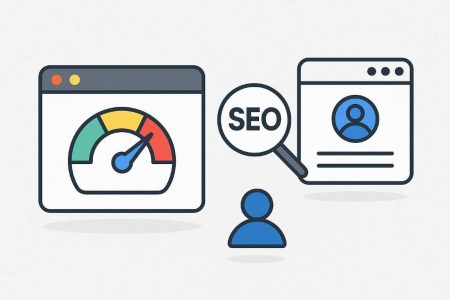In recent years, a new mantra has taken hold in the world of SEO: “A fast site is good for SEO.” But behind this seemingly indisputable statement lies a more nuanced reality. Is page speed truly a ranking factor, or just a UX lever that Google uses to push for a healthier web?
Google and Speed: A Double-Edged Message
As early as 2010, Google announced that site speed was one of the factors taken into account in page rankings. The introduction of the Core Web Vitals in 2020 reinforced this message, with precise metrics like LCP (Largest Contentful Paint) and CLS (Cumulative Layout Shift).
But if we look closely at Google’s messaging, a subtle truth emerges: the SEO impact of speed is minimal. It only acts as a factor in extreme cases — such as very slow or unstable sites — and is far less influential than other signals like search intent, content quality, or backlinks.

What Studies and Real-World Cases Show
A/B tests conducted by SEO experts (particularly on e-commerce or media sites) reveal that improving page speed does not consistently lead to better rankings. However, it does improve:
- Conversion rates
- Bounce rates
- Number of pages viewed per session
In other words: the gains are more UX-driven than SEO-related. A website that loads in 1.5 seconds instead of 3 seconds won’t necessarily rank higher in search results — but it will keep visitors on the page longer.
The Confusion Between UX and Technical SEO
SEO consultants often talk about speed optimization in their audits. Why? Because technical performance impacts both crawling (crawl budget) and how users perceive the site.
Google also evaluates post-click behavior: session duration, internal clicks, bounce rate…
A fast website encourages navigation. These indirect behavioral signals can improve your rankings — more so than raw loading speed alone.
What Really Matters: Finding the Right Balance
Focusing solely on your PageSpeed score can be counterproductive. A “perfectly fast” site that’s poorly structured or lacks strong content will bring no real SEO benefit. On the other hand, a high-quality site that’s slightly slower — but relevant and well-organized — will rank better.
Here’s what to prioritize:
- High-quality content first
- A clean technical structure (semantic tags, mobile-first, accessibility)
- Decent loading speed (LCP under 3 seconds)
- A smooth, mobile-friendly user experience
Conclusion: A UX Lever, With SEO Bonus
In the end, page speed is a UX foundation and a bonus for SEO. Google won’t reward you just because your site is fast — but it might penalize you if your site is so slow that it frustrates users.
Need a Useful Technical Audit?
At Linkeo, we help small businesses optimize their websites in concrete ways: structure, content, mobile experience, speed, local SEO, and lead generation. If you’re unsure about your site’s performance or want to take things further, our team is here to help.
👉 Contact us for a clear, jargon-free, results-oriented diagnosis.
Useful Resources
- Google’s official Core Web Vitals page – Learn about the 3 key metrics (LCP, FID, CLS) and how they impact UX.
- PageSpeed Insights – Analyze your site’s speed according to Google’s standards, with tips for improvement.
- Google Search Central guide on page experience – Everything Google officially says about speed, mobile usability, and interactivity.
- Backlinko study on ranking factors – A data-driven look at what really affects SEO performance, including speed.
- Ahrefs: Is speed really a ranking factor? – A deep dive into how much performance matters for SEO.
- GTmetrix – A helpful tool for testing and optimizing speed, with detailed performance charts.